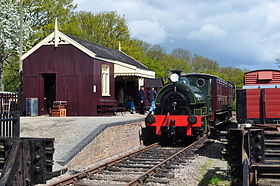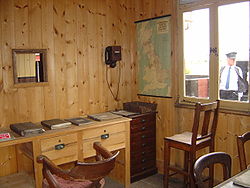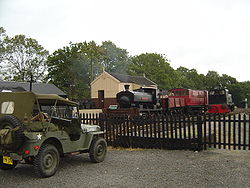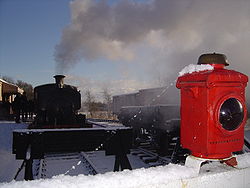- Mid-Suffolk Light Railway
-
Mid-Suffolk Light Railway 
Falmouth Docks in full steam. Locale England Terminus Brockford Commercial operations Name Mid-Suffolk Light Railway Built by Mid-Suffolk Light Railway Original gauge 4 ft 8 1⁄2 in (1,435 mm) Preserved operations Operated by Mid-Suffolk Light Railway Stations 1 Length 0.5 miles (0.8 km) Preserved gauge 4 ft 8 1⁄2 in (1,435 mm) Commercial history Opened 1908 Closed 1952 passengers Preservation history 1992 Formation of preservation company Mid-Suffolk Light Railway 



Authorised extension to Halesworth (not built) 



Cratfield (limit of line built) 



Cake Street LC 



Gorams Mill Lane LC 



Station Road LC (B1117) 



Laxfield 



Stirrup Street LC 







Russell Green Road LC 



Wilby 



Neaves Lane LC 



Wilby Road LC (B1118) 



Stradbroke 



Worlingworth Road LC 



Horham 



Athelington Road LC 



Southolt Road LC 



Worlingworth 



Water Lane LC 



Shop Street LC 



Hall Road LC 



Kenton Road LC 



Kenton 







Eye Road LC 



Aspall Road (B1077) 



Aspall and Thorndon 



B1077 LC 



Little London Hill LC 



Proposed Debenham station 



Authorised extension to Westerfield (not built) 



High Lane LC 



Blacksmith Lane LC 







Brockford and Wetheringsett 



Station Road LC 



Brockford Green Road LC 



The Street (A140) 



Oak Farm Lane LC 



Hobbies Lane LC 



Station Road LC 



Mendlesham 



Hoggars Road LC 



Lambert's Lane LC 



Gipping Siding 



Brown St LC 



Finningham Road LC (B1113) 



Silver Street LC 


Haughley 



Great Eastern Main Line 



Ipswich to Ely Line The Mid-Suffolk Light Railway (aka The Middy) is a heritage railway in Suffolk, which in its heyday it was a branch line which ran for just 19 miles (31 km) from Haughley to Laxfield, Suffolk. The line became part of the LNER in 1924 and the last trains ran on 26 July 1952. The Railway is now both a heritage railway and preservation museum run by a small but dedicated band of volunteers. The Mid-Suffolk Light Railway is currently the only steam preservation railway in Suffolk. There are plans to extend in each direction along the line.
Contents
History
Construction
The line was intended to run from Haughley to Halesworth, with a second branch running from Kenton station to Westerfield near Ipswich. The Mid-Suffolk Light Railway, or Middy as it became affectionately known, was built to provide transport to the rural Suffolk communities who had no reliable transport links. It was built in accordance with the 1896 Light Railways Act, which allowed for cheaper construction methods in return for a speed restriction of 25 mph. The railway was built as cheaply as possible: the buildings were constructed using corrugated iron, and the route followed the natural contours of the land to minimise the need for embankments and bridges. The section from Haughley to Laxfield was completed and open for passenger traffic. Beyond Laxfield the line was built for approx mile to Cratfield over which an occasional freight train was run but the section fell into disuse. Some earthworks were begun between Cratfield and Halesworth but these were soon abandoned with now no evidence remaining. The section of about two miles of the branch from Kenton to Westerfield was completed as far as Debenham and a few goods trains were run but this also was soon abandoned. Some sections of trackbed and embankments still survive.
Opening
The railway was built too late, long after the great railway boom that had affected the country in the Victorian age, and soon came into financial difficulties. The planned railway had troubles from the very beginning, having disputes with the neighbouring Great Eastern Railway (GER) and local landowners. The railway was bankrupt before it opened. It was pure determination that kept the Middy running. The Railway opened to freight traffic in 1904 with the hope that this would bring in enough income to complete the line, but by 1908, although the line was making an income, it still was not enough to cover its original debts and for work to continue. Finally on Tuesday 29 September 1908 the line was opened to passengers with two trains in either direction on weekdays, but this failed to bring great trade as many of the stations were sited miles from the communities they were meant to serve.
London and North Eastern Railway
In 1924 the Middy lost its independence and was grouped together with the London and North Eastern Railway (LNER), but apart from the replacement of second-hand rolling stock, the railway continued as it always had done. The railway's original LNER Class J64 locomotives were replaced by LNER Class J65 or "Blackwall Tanks" which were eventually replaced by the older but stronger LNER Class J15.
The passenger traffic began to decline over the next couple of decades as more people bought motorcars and goods traffic was increasingly going by road. This all changed with the beginning of the Second World War. With petrol rationing, the Middy became an important transport link and with US airbases built near the Mendlesham and Horham stations, the line was relied upon for transporting military equipment and regularly used by American serviceman. The war brought more traffic to the line – both goods and passengers – as the railway became important in helping the war effort. This all came at a cost to the railway. No effort was made to maintain the rolling stock or the line itself, like the rest of Britain's railway network.
British Railways
After the war the Middy entered into the ownership of British Railways in 1948. Although business was dwindling and the line was in a state of neglect and decay after being exhausted during WW2, the line became an attraction for enthusiasts and railway management due to the picturesque landscape through which the railway ran; and its informal atmosphere. The end of the war meant a surplus of ex-army lorries which took away the agricultural business, the main source of income for the line. The Middy eventually closed in 1952, 44 years after it had opened for passenger traffic.
Renaissance
Nearly 40 years after it closed, a group of enthusiasts formed a Company to recreate the Middy on the site of the Brockford and Wetheringsett railway station, now the corner of a large field.
The task ahead
The Mid-Suffolk Light Railway Society had an ambitious task ahead of them due to the temporary nature of the original line. As far as is known, no coaches or locomotives of the Middy are still in existence and the corrugated iron buildings were either left to rust or sold to become farm sheds. However, the Company has been recreating typical scenes from the Middy's past by using restored coaches and wagons that would have run on its bigger neighbour, the Great Eastern Railway, and its successor, the London & North Eastern Railway. The Society has been able to collect a number of Great Eastern coaches, one of which is in working order, with many more under restoration. The museum has also been able to collect the remaining station buildings from former Middy railway stations.
Non-railway artifacts
The one aim of the society which makes it stand out from any other railway museum is that they are not just interested in getting a locomotive and coaches and taking passengers up and down the line. Goods wagons, road going railway delivery vehicles and line side artifacts are given just as much care and attention as the main attractions.
Another aim of the society is to bring together an archive of photos and original artifacts from the working life of the Mid-Suffolk Light Railway. Many of these are on display at the museum.
Operation
The museum operates from April to the end of September on Sundays and Bank Holidays, with Santa specials in December. Most of the Open Days have a Special Event to accompany the running of the steam locomotive.
A full list of the events and activities can be found on the Mid-Suffolk light railway society's web site.
Locomotives
Original
- LNER Class J64
- LNER Class J15
Current
The museum currently has two locomotives, "Alston" which is under restoration on site and a Ruston diesel. The museum also uses privately owned locomotives for the steam events:
- Hawthorn Leslie 0-4-0ST "Falmouth Docks and Engineering Co. Loco No. 3" – operational
- Andrew Barclay 0-4-0ST "Little Barford" – under restoration
- Hudswell Clarke 0-6-0ST "Alston" – under restoration
- Ruston 0-4-0DM diesel-mechanical
Rolling stock
- GER 180 Horse box (body only) built 1869, under restoration
- GER 278 Four-wheel Third built 1876 , under restoration
- NER 131 Six-wheel Full Brake (body only), under long term restoration
- GER 13 Four-wheel Brake Third (body only) built 1875, Body on chassis ex LNER 'Queen Mary' type brakevan. Operational from 2003.
- GER 1266 Third (body only now on ex-tube wagon uderframe) built 1891, under restoration
- GER 287 Third (body only) built 1876, under long term restoration
- GER 140 First (body only) built 1863. Operational from 2009
- GER 424 Third, later Second (body only) built 1892, under restoration
There are also several wagons and freight Items that are under restoration and operational.
Claims to Fame
Lord Kitchener visited the still incomplete railway on 23 September 1902 after spending the night at Aspall. He travelled over the railway from Brockford to Haughley, where he continued his journey to Stowmarket by road.[1]
The Middy was short-listed as the location for the 1952 Ealing Studios film The Titfield Thunderbolt, but the Camerton and Limpley Stoke line south of Bath was used instead.
The Railway was used as inspiration for the John Hadfield novel, Love on a Branch Line. The book was first published in 1959 and was turned into a television series in 1994.
Villages
During its operating life the Middy serviced the following villages:
- Haughley
- Gipping (freight only)
- Mendlesham
- Brockford
- Aspall
- Kenton.
- Debenham (brief freight service)
- Worlingworth
- Horham
- Stradbroke
- Wilby
- Laxfield
Notes
- ^ Comfort 1997, p. 17.
References
- Comfort, N. A. (1986) [1964]. The Mid-Suffolk Light Railway (2nd ed.). The Oakwood Press. ISBN 0-85361-338-9.
- Comfort, Nicholas (1997) [1964]. The Mid-Suffolk Light Railway. Locomotion Papers (3rd ed.). Headington: Oakwood Press. ISBN 0 85361 509 8. LP22.
- Paye, P. (1986). The Mid-Suffolk Light Railway. Wild Swan Publications. ISBN 1 874103 81 X.
External links
- The Mid-Suffolk Light Railway Society – official website
- The London & North Eastern Railway (LNER) Encyclopedia
- The Great Eastern Railway Society
- Aspall and Thorndon station (MSLR line) on navigable 1946 O. S. map.
- The Vintage carriage trust website
Closed railway stations in Suffolk Aldeburgh Branch Framlingham Branch Mid-Suffolk Light Railway Haughley · Mendlesham · Brockford and Wetheringsett · Aspall and Thorndon · Kenton · Worlingworth · Horham · Stradbroke · Wilby · LaxfieldGreat Eastern Main Line Felixstowe Branch Line Stour Valley Railway Long Melford to Bury St Edmunds Branch Thetford to Bury St Edmunds line Cambridge to Mildenhall railway Norfolk and Suffolk Joint Railway Hadleigh Branch Eye Branch Southwold Railway Wenhaston · Blythburgh · Walberswick · SouthwoldOther lines Bealings · Bungay · Haverhill (CVHR) · Haughley · Haughley Road · Higham · Ipswich Stoke Hill · Saxham & Risby · Newmarket (1848 station) · Newmarket Warren HillCategories:- Mid-Suffolk Light Railway
- Railways authorised but not built in the United Kingdom
- Disused railway stations in Suffolk
- Heritage railways in England
- Visitor attractions in Suffolk
- Museums in Suffolk
- Railway museums in England
- Railway lines closed in 1952
Wikimedia Foundation. 2010.





